Dec 15, 2021 | history, tokens
As I have been searching for hometown numismatics, I have been coming across merchant tokens that advertises deed to land for what seems to be a low price. All of the tokens have a Manhattan address, and all say that the business is open until 9 P.M.
None of the tokens have dates, but all have the same address. One side of the token describes what is being offered:
Finder will Receive / Deed to / One $150 / Building Lot / High and Dry / Near America’s / Finest Seashore Resort / Only $36.50/ Transfer Charge. / No Other Expenses / Open Evenings / Until 9 P.M.
The reverse says that the token has to be returned within 96 hours to the Advertising Department, Room 1274, in the Longacre Building at the corner of 42nd Street and Broadway.
According to public data available online, the Longacre Building was a 12-floor building in Times Square that opened in 1912. Before 1904, Times Square was known as Longacre Square, and the area was renamed when the New York Times opened its headquarters on the property of the old Pabst Hotel.
Some websites documenting old New York City buildings identify the same address as the Longacre Hotel from 1917 through 1932. It is possible that the building was turned into an inexpensive hotel, and the advertiser rented a room at the hotel.
Documentation suggests that the city demolished the building during the Great Depression using New Deal funding.
As I was looking for answers, a friend that is a professor in one of the city’s many colleges speculates that a Florida government issued the token. Early in the 20th century, Florida governments came to New York to entice New Yorkers to move to areas north of Miami or purchase land for second homes.
The condition of the sale or deed transfers is not known.
Many of New York City’s historical records are held at the main New York Public Library, not far from the Longacre Building once stood. Some day, I will go to the library to research the old records to find the story behind these tokens. Maybe it is an excellent excuse to go home in time for NYINC.
Jul 21, 2020 | history, tokens

The Dahlberg Radio in a hospital setting
Newspapers were the dominant media of the day. Many broadsheets published two or three times a day plus special editions. The provided news, stories, and advertising, but there was always a delay. Broadcast radio began to change how news was delivered, starting with the first commercial radio stations in the early 1920s. Although the first radio stations experimented with the new format, by the late 1920s, radio offered a wide range of programming.
Like all new technology, radios were expensive. Manufacturing processes would take a while to lower costs. But as radio began to become popular, the Great Depression slowed its growth.
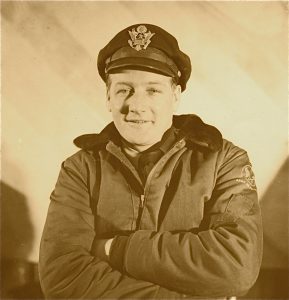
Ken Dahlberg
Dahlberg sold tokens to the hospital with their name on it in an attempt from people taking the tokens to other hospitals. The tokens were the size of a dime with a hole in the center. It was a pay-per-listen radio when the medium was popular. By the mid-1950s, technology reduced the size of the radio, and the family of patients brought their radios.
-
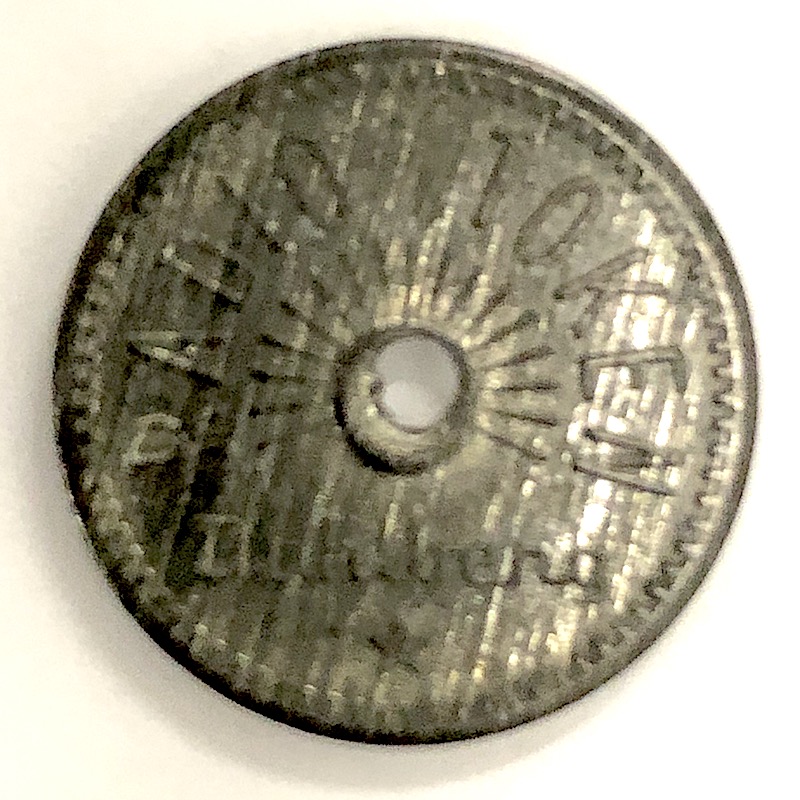
-
The common obverse of the Dahlberg Radio Token
-
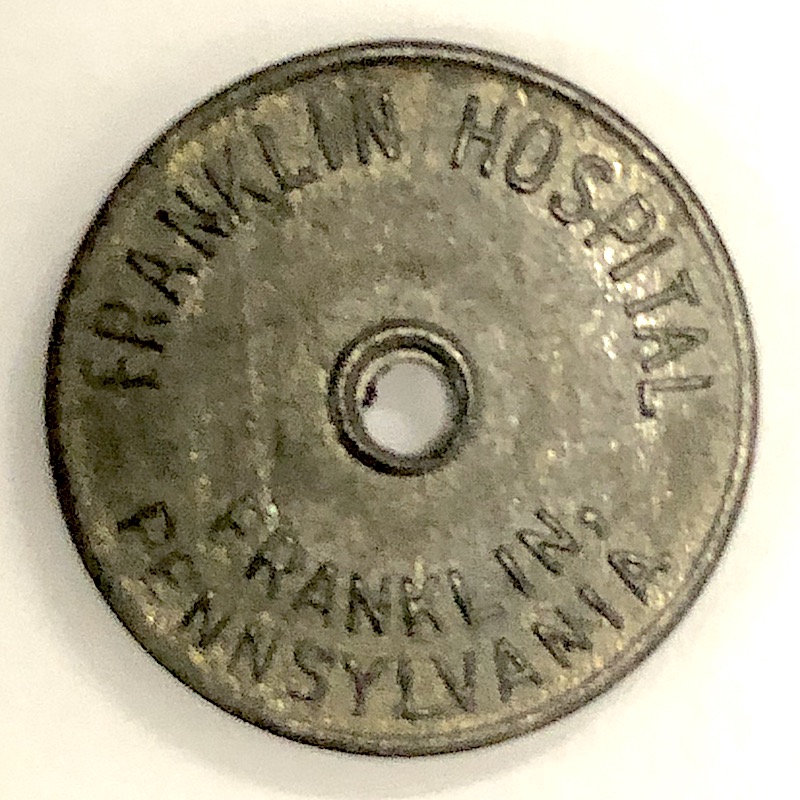
-
Reverse of a Dahlberg Radio Token from Franklin Hospital in Franklin, PA
Dahlberg stopped making radios in the early 1960s to pursue other ventures. The hearing aid company Miracle-Ear was a subsidiary of Dahlberg electronics.
In 1972, Ken Dahlberg was the midwest finance chair for the Committee to Re-Elect the President. Dahlberg facilitated the payments that eventually found its way into the bank account of one of the Watergate burglars. He was never charged with a crime since it was clear he was following the campaign finance procedures and did not have knowledge of where the money was going.
Dahlberg radio tokens are scarce but not difficult to find. People who collect these tokens look for different hospitals, and different cities struck in the metal. One collector said that he had found tokens from 21 different hospitals in 20 different cities. Collectors do not know the number of hospitals that had tokens made, and there has been no attempt to document the ones found.
The tokens pictured above were found mixed with other collectible items. Their discovery allowed for a look back to an interesting past.
If you like what you read, share, and show your support 
Oct 11, 2018 | currency, education, exonumia, medals, tokens
I was going to stop doing the LOOK BACK series after the summer, thinking I would have time to create new content. But we all know that real life has a way of changing even the best-laid plans. While fighting off a severe sinus infection thanks to the mold spores that thrive in this damp weather, business picked up. I am ecstatic that my new business is catching on but the infection put a damper on things.
I need a week to catch up. While doing so, I will publish two more LOOK BACK articles and try to finish a few of the new posts I started. For today’s LOOK BACK, I want to remind everyone that numismatics is more than coins. You can satisfy your collecting urges with exonumia as well as with coins.
Although the dominant area of numismatics is the collection and study of legal tender coins, numismatics is more than just coins. Numismatic is the collecting and study of items used in the exchange for goods, resolve debts, and objects used to represent something of monetary value. This opens up numismatic collecting to a wide range of items and topics that could make “the hunt” to put together the collection as much fun as having the collection.
Exonumia is the study and collection of tokens, medals, or other coin-like objects that are not considered legal tender. Exonumia opens numismatics to a wide variety of topics that could not be satisfied by collecting coins alone. An example of exonumia is the collection of transportation tokens. You may be familiar with transportation tokens from your local bus or subway company who used to sell tokens to place into fare boxes. Others may have used tokens to more easily pay in the express lanes at bridges and tunnels. A person who collects transportation tokens is called a Vecturist. For more information on being a Vecturist, visit the website for the American Vecturist Association.
Token collecting can be the ultimate local numismatic collection. Aside from transportation tokens, some states and localities issued tax tokens in order to collect fractions of a cent in sales taxes to allow those trying to get by in during down economic times to stretch their money further. Some communities issued trade tokens that allowed those who used them to use them like cash at selected merchants. Some merchants issued trade tokens that were an early form of coupons that were traded as coupons are traded today.
While tokens are items used to represent monetary value, medals are used to honor, commemorate, or advertizing. The U.S. Mint produces medals that honor people, presidents, and events. Medals produced by the U.S. Mint are those authorized by law as a national commemoration including the medal remembering the attacks of 9/11.
Commemorative medals are not limited to those produced by the U.S. Mint. State and local governments have also authorized the producing medals on their behalf that were produced by private mints. Many organizations also have created medals honoring members or people that have influenced the organization. Companies have produced medals to honor their place in the community or something about the company and their community.
Many medals have designs that can be more beautiful than on coins since they are not limited to governmental mandated details and their smaller production runs allows for more details to be added. Medals can be larger and thicker than coins and made in a higher relief than something that could be manufactured by a government mint.
Exonumia collecting also involves elongated and encased coins. You may have seen the machines in many areas where you pay 50-cents, give it one of your cents, turn the wheel and the cent comes out elongated with a pattern pressed into the coin. Elongated coins have been used as advertisements, calling cards, and as a souvenir.
Encased coins are coin encircled with a ring that has mostly been used as an advertisement. One side will call the coin a lucky coin or provide sage advice with the other side advertising a business. Another form of encased coins are encased stamps. Encased stamps were popular in the second half of the 19th century and used for trade during times when there were coin shortages.
Other exonumia includes badges, counter stamped coins, wooden money, credit cards, and casino tokens. Counter stamped coins are coins that have been circulated in foreign markets that were used in payment for goods. When the coin was accepted in the foreign market, the merchant would examine the coin and impress a counter stamp on the coin proclaiming the coin to be genuine based on their examination. Although coins were counter stamped in many areas of the world, it was prevalent in China where the coins were stamped with the Chinese characters representing the person who examined the coin. These Chinese symbols are commonly referred to as “chop marks.”
One type of counter stamped coins are stickered coins. Stickered coins were popular in the first half of the 20th century; they were used as an advertisement. Merchants would purchase stickers and apply them to their change so that as the coins circulated, the advertising would reach more people. Some stickered coins acted as a coupon to entice the holder to bring the coin into the shop and buy the merchandise.
Remember the saying, “Don’t take any wooden nickels?” If you are a wooden money collector, you want to find the wooden nickels and other wooden denominations. Wooden nickels found popularity in the 1930s as a currency replacement to offer money off for purchases or as an advertisement. Wooden nickels are still being produced today mostly as an advertising mechanism.
We cannot end the discussion of exonumia without mentioning Love Tokens and Hobo Nickels. Love Tokens became popular in the late 19th century when someone, usually a man, would carve one side of a coin, turn it into a charm for a bracelet or necklace, and give it to his loved one. The designed are as varied as the artists who created them. Hobo Nickels are similar in that hobo artists would carve a design into a Buffalo Nickel to sell them as souvenirs. While there are contemporary Love Tokens and Hobo Nickels, collectors have an affection for the classic design that shows the emotion of the period.
Currency collecting, formally called notaphily, is the study and collection of banknotes or legally authorized paper money. Notes can be collected by topic, date or time period, country, paper type, serial number, and even replacement or Star Notes (specific to the United States). Some consider collecting checks part of notaphily. Collectors of older canceled checks are usually interested in collecting them based on the issuing bank, time period, and the signature. For the history of currency and their collecting possibilities, see my previous article, “History of Currency and Collecting”.
Scripophily is the study and collection of stock and bond certificates. This is an interesting subset of numismatics because of the wide variety of items to collect. You can collect in the category of common stock, preferred stock, warrants, cumulative preferred stocks, bonds, zero-coupon bonds, and long-term bonds. Scripophily can be collected by industry (telecom, automobile, aviation, etc.); autographs of the officers; or the type of vignettes that appear on the bonds.
Militaria: Honorable Collectibles
Collecting of military-related items may be considered part of exonumia but deserves its own mention. It is popular to collect military medals and awards given to members since the medals themselves are works of art. Families will save medals awarded to relatives and even create museum-like displays to honor or memorialize the loved one.
Militaria includes numismatic-related items that represent the various services. One of the growing areas of collectibles is Challenge Coins. A challenge coin is a small medal, usually no larger than 2-inches in diameter, with the insignia or emblem of the organization. Two-sided challenge coins may have the emblem of the service on the front and the back has the emblem of the division or another representative service. Challenge coins are traditionally given by a commander in recognition of special achievement or can be exchanged as recognition for visiting an organization.
Over the last few years, civilian government agencies and non-government organizations (NGO) have started to create and issue challenge coins. Most of those agencies have ties to the military, but not all. Like their military counterparts, a manager or director can give challenge coins in recognition of special achievement or for visiting an organization.
Another area of military collectibles is Military Payment Certificates (MPC). MPC was a form of currency that was used to pay military personnel in foreign countries. MPC was first issued to troops in Europe after World War II in 1946 to provide a stable currency to help with commerce. MPC evolve from Allied Military Currency (AMC) to control the amounts of U.S. dollars circulating in the war zone and to prevent enemy forces from capturing dollars for their own gain. Prior to World War II, troops were paid in the currency of the country where they were based. With the ever moving fronts and the allies need to control the economies to defeat the Axis powers, AMC was issued to allow the military to control their value.
After the war, MPC replaced APC in order to control the currency and prevent the locals from hoarding U.S. dollars preventing the building of their own economies. When military officials discovered that too many notes were in the circulation, being hoarded, and thriving on the black market, series were demonetized and reissued to military personnel. Those holding MPC notes, not in the military received nothing and were encouraged to circulate their own currency.
MPC were printed using lithography in various colors that changed for each series. From the end of World War II to the end of the Vietnam War there were 15 series printed with only 13 issued. Although the two unissued series were destroyed, some examples have been found in the collections of those involved with the MPC system. Amongst the 13 series that were issued, there are 94 recognized notes available for collectors. Most notes are very affordable and accessible to the interested collector.
The original article can be read here.
Sep 4, 2018 | education, foreign, tokens
Now that I am running a collectibles business, I see a number of interesting items coming into the shop.
Last week, someone came into the shop with items that she wanted to sell in order to downsize prior to moving. One of the items was a small plastic bag of foreign coins. The bag contained a lot of low-value base metal coins that would trade for under one dollar from a dealer’s junk box.
Although I do not keep a large inventory of coins, I have a basket I fill with foreign coins for anyone who wants to look through them. I will sell the coins for 25-cents each even if they are worth more. When parents come into the shop with their children, I will let the kids pick out a coin. I challenge them to go online and learn what they can about the coin.
Sometimes, my assistant and I will look through the basket for something interesting. While my assistant is not a collector, she knows I am and looks for specific items I am looking for (more on that another time) and anything that looks interesting.
After moving furniture in the warehouse, I returned to my desk and found a small pile of coins. Some were part of the coins I was looking for and a token with the date of 1895. What is this coin?
-
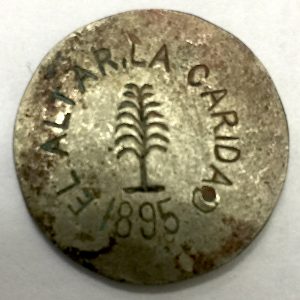
-
Obverse of a token from Hacienda El Altar and La Caridad. The plant in the center is likely a cane that was popular in the region.
-
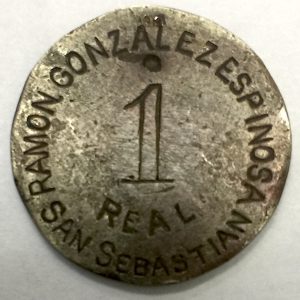
-
Reverse of a Hacienda El Altar and La Caridad token declaring they were owned by Ramón González Espinosa from San Sebastián and is worth 1 Real.
On the obverse and above the date is a tree. The legend around the coin says “EL ALTAR, LA CARIDAD.” On the reverse, it gives the denomination of “1 REAL” and the legend says “RAMON GONZALEZ ESPINOSA” and “SAN SEBASTIAN.” Immediately, I think this is a Spanish coin.
San Sebastián is a coastal city in the Basque region of northern Spain close to the French border. Although there is evidence of human settlement from at least 24,000-22,000 BCE, the earliest recorded evidence dates to 1014 and the monastery of St. Sebastián.
But there was no reference of a 1 real coin being issued in the region in the late 19th century or anyone in the region named Ramón González Espinosa.
Who was Ramón González Espinosa? Trying an Internet search of that name finds people with that name in California, Texas, and elsewhere around the world. Searching for Espinosa and San Sebastián also lead to a lot of irrelevant results.
Next was to figure out what El Altar and La Caridad represent. El Altar is “The Alter” in Spanish and La Caridad translates to “The charity.” Could this have been a token used to try to raise money in Spanish speaking country other than Spain?
Just to see what would happen, rather than using google.com, I went to google.com.mx, the site that serves Mexico and Latin America. I entered the information for all of the legends and searched. When too many items came up and my rudimentary Spanish found that they were irrelevant, adding quotes around each phrase lead found an interesting page.
On a blog that is written by a Venezuelan numismatist, there was an article with an image of the same token. Using translation software, I was able to obtain enough information to learn more about the token.
During the late 19th century, Venezuela was undergoing a financial crisis that caused a severe coin shortage. The situation became so bad that the haciendas, plantations in Venezuela, could not pay their workers. To help solve the problem, hacienda owners would create their own tokens to act as promissory notes. They would pay their workers using these tokens. When coins were available, the hacienda owner would pay the merchants.
These tokens circulated as money throughout the region.
The token we found was from the Hacienda El Altar and La Caridad, both were the properties of Ramón González Espinosa. Espinosa’s properties were located in Aragua State
The haciendas were in San Sebastián de los Reyes (Saint Sebastian of the Kings) in Aragua State. The town is located on the Guárico River that leads to the Caribbean Sea. El Altar and La Caridad were livestock farms.
It is unusual for the names two haciendas to appear on a single token. According to references about other tokens from this era, when the same person owned multiple haciendas they had tokens made for each of their properties to distinguish the accounts from each other. Since there were no other references for tokens with more than on hacienda, it is not known as to why Espinosa created only one token.
Most tokens from this era were made using a copper-nickel alloy that ranged from 40-60 percent nickel. Most were thin discs and had different shapes. Hacienda tokens ranged in value from ½ Real to 5 Reales. Tokens from Hacienda El Altar and La Caridad were issued in ½, 1, 2, and 4 Reales.
The Venezuelan government continued to have a difficult time producing enough coinage. After Cipriano Castro seized the government in Caracas, he contracted with the Mexico City Mint to produce low denomination copper coins. In 1902, Venezuelan government contracted with the U.S. Mint to produce lower denomination silver coins.
Slowly, there was enough of a coin supply that it ended the need for hacienda tokens. But they continued to circulate because hacienda owners used it as a way to control their workers. When Juan Vicente Gómez overthrew Castro, who left Venezuela in 1908 for medical treatment in Germany, he instituted a rule to end the circulation of these tokens by ordering the hacienda owners to buy back the tokens using state currency.
It is estimated that over 10,000 tokens were once in circulation. After the order was given to redeem the tokens most were melted and used for other purposes.
Although it is rare to find one, they are not worth much in the numismatic market. However, finding one allowed me to learn more about its origin, hacienda tokens, and how the United States helped in ending this practice.
In other words, yet another reason why numismatics is a fun hobby!
Sep 2, 2018 | coins, foreign, news, tokens
There is always something in numismatics that can be used to teach us about history. This past week it was reported that Russian archeologists found a rare “beard kopek.” It was a coin that men had to buy if they wanted to remain unshaven under the rule of Peter the Great.
-
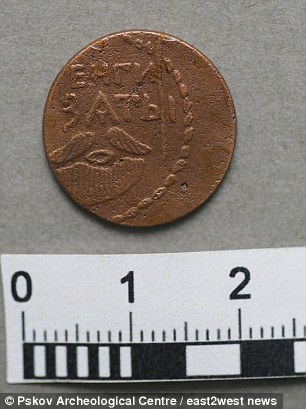
-
Obverse of Beard Tax copper token issued under the reign of Czar Peter the Great.
-
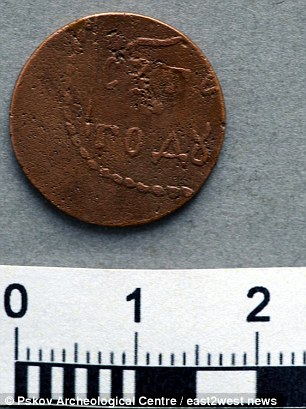
-
Reverse of the Beard Tax token. Note the off-center strike on this hammered token.
Peter rose to power at the age of 17 in 1689, but the arcane succession rules of Russia did not allow him to actually rule until his mother died in 1694. Then, he had to be co-ruler with his brother Ivan V until Ivan died in 1696. That is when Peter took over.
Once Peter became the sole czar he implemented sweeping reforms to modernize Russia. He thought that in order to become a power similar to those of Western Europe, Russian society had to evolve. Using western advisors and his command of the military, he forced reforms on the country including violently suppressing uprisings by those who did not agree with him.
To enforce his idea of modernization, he introduced western dress to his court and required all government officials to adopt this more modern style of dress. Robes and beards were no longer accepted under Peter’s rule. In order to enforce his idea, Peter began to levy taxes on people who would not comply. If you wanted to keep your beard you had to pay a tax. Once you paid a tax you would be required to carry around a token saying that you paid the tax.
The copper token found in Russia was one of those beard tax tokens. It has an image of a beard and mustache with the words “Money Paid” (in Russian) surrounded by a beaded border. If you wanted to keep your facial hair, you paid the tax and had to carry around the token as proof.
Reports claim that this is only the second known Beard Tax token to exist with the other one being in The State Hermitage Museum in Saint Petersburg, Russia. However, a silver version of the token was sold by Heritage Auctions in September 2017 as part of the Long Beach Expo World Coins Signature auction. The hammer price for that token was $3,000.
Even if there were two more found, it would still be a rare token!
And now the news…

August 27, 2018
Aaron Coulson was given the silver coin in a Sutton Coldfield pub – and thinks it's worth at least £100  → Read more at birminghammail.co.uk
→ Read more at birminghammail.co.uk

August 27, 2018
In 1698, Tsar Peter the Great of Russia, as he would come to be know, was waging a war on beards. In an attempt to modernize his empire and make it more like the west after spending years exploring Europe in disguise, Peter instituted a tax on facial hair.  → Read more at popularmechanics.com
→ Read more at popularmechanics.com

August 27, 2018
The United States Mint has issued an open call for artists to design the nation’s coins and medals as part of its its Artistic Infusion Program. The government is particularly interested in artists who will “bring innovative perspectives and utilize symbolism in their work to clearly and evocatively convey subjects and themes,” according to the program’s press release.  → Read more at news.artnet.com
→ Read more at news.artnet.com

August 28, 2018
AUGUSTA, Maine (WABI) – Attention all Maine artists: The Maine Bureau of Veterans' Services has an important job for you. They're looking for an artist to design a coin for post-Vietnam War and peacetime veterans.  → Read more at wabi.tv
→ Read more at wabi.tv

August 30, 2018
A MAN uncovered a horde of Roman coins buried in farmland. Allan Hughes, of Wrexham, found five silver Denarii coins dating back nearly 2,000 years while out searching with a metal detector on arable land in Cockshutt, near Ellesmere.  → Read more at leaderlive.co.uk
→ Read more at leaderlive.co.uk

September 1, 2018
The South African government is considering a range of initiatives to increase the demand for platinum-group metals (PGMs), including the development of a Mandela Platinum Coin. The proposal to develop a Mandela Platinum Coin is based on the international success achieved by the Kruger Rand, South Africa’s Mineral Resources Minister Gwede Mantashe said at the Africa Downunder conference, in Perth.  → Read more at miningweekly.com
→ Read more at miningweekly.com

September 2, 2018
A First Century silver Roman coin uncovered on land in Shropshire has been declared treasure trove at an inquest.  → Read more at shropshirestar.com
→ Read more at shropshirestar.com
Dec 31, 2017 | exonumia, news, tokens
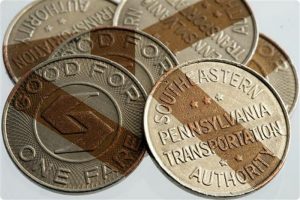 The end of the year comes with a lot of endings. This year will mark the beginning of the end for the last major metropolitan area still using transportation tokens.
The end of the year comes with a lot of endings. This year will mark the beginning of the end for the last major metropolitan area still using transportation tokens.
Just before Christmas, the Southeast Pennsylvania Transportation Authority (SEPTA), the transit agency serving the Philadelphia metropolitan region, announced that they are removing the token vending machines at El (elevated rail stations) and subway stops. The announcement said that they will continue to sell tokens at some stations and the system will continue to accept them.
SEPTA has seen a 1 million token decline in sales just in the last year as people opt to use a SEPTA Key Card and daily QuickTrip passes. It is a trend experienced nationwide. It is the result of better use of electronic payment systems and the increased cost of handling tokens. The cost of credit card swipe fees is less expensive than the physical handling of metal disks.
Farecard technology has been around for a while. I first encountered it in the early 1990s during a trip to Washington, D.C. The Washington Metro began using fare cards as a pilot in 1989 and rolled them out system-wide in 1990. My hometown of New York launched the MetroCard in 1993 and stopped using tokens in 2003.
One of the benefits of the fare cards to the transit agencies is that they can charge differing rates for different situations. Peak fares can cost more than the non-peak while using an express service can be charged an additional fare without having to carry extra tokens. The Washington Metro not only changes fares between peak and off-peak times but charges a different fare based on distance.
Be prepared Philadelphia, the days of the single fare ride for a token is almost over.
And now the news…

December 24, 2017
CAIRO, Dec. 24 (Xinhua) — Egyptian security at the Cairo International Airport has thwarted an attempt to smuggle 329 ancient coins to France, the Ministry of Antiquities said on Sunday. The coins, seized from an Egyptian passenger travelling to France, date back to the Byzantine and Ptolemy eras, the ministry said in a statement.  → Read more at xinhuanet.com
→ Read more at xinhuanet.com

December 24, 2017
The Currency Museum shows how diverse our units of commerce have been THE BANK of Japan’s Currency Museum in Tokyo exhibits mainly currencies that have been circulated in Japan, including fuhonsen coins said to be the first ever used in this country, toraisen coins imported from China during the medieval period, and oban and koban (large and small gold coins).  → Read more at nationmultimedia.com
→ Read more at nationmultimedia.com

December 26, 2017
The first ever English gold coin that had to be scrapped after a banking blunder meant is was worth less than its weight in gold, is now tipped to sell for £500,000. Some 52,000 of the King Henry III gold pennies were struck nearly 800 years ago before it was realised they were too heavy.  → Read more at dailymail.co.uk
→ Read more at dailymail.co.uk

December 26, 2017
A typewriter clacking. A droning busy signal on a landline.  → Read more at philly.com
→ Read more at philly.com

December 27, 2017
BACOLOD CITY— The Bangko Sentral ng Pilipinas (BSP) urged consumers in Negros Occidental to thoroughly check the features of the new PHP5 coins already circulating in the province. “We urge Negrenses to check the features, mainly the appearance of the coins they have, to ensure that they spend the right amount,” said Job Nepomuceno, deputy director of BSP-Bacolod.  → Read more at canadianinquirer.net
→ Read more at canadianinquirer.net

December 27, 2017
That's a lot of pocket change. We’ve all done it at some point. Yes, all of us.  → Read more at motor1.com
→ Read more at motor1.com

December 27, 2017
Coin proof set from the reign of William IV and dated 1831 which sold for £65,000 at London auction house Dix Noonan Webb on December 13-15. Three excellent 19th century examples sold in the Coins, Historical Medals and Paper Money auction held by London saleroom Dix Noonan Webb in London on December 13-15.  → Read more at antiquestradegazette.com
→ Read more at antiquestradegazette.com

December 28, 2017
What: World Coins Where: Heritage Auctions, 445 Park Ave, New York, NY 10022, USA When: 7 January, 03.50pm CT  → Read more at blouinartinfo.com
→ Read more at blouinartinfo.com

December 30, 2017
THERE are fears fake pound coins are flooding into circulation.  → Read more at dailystar.co.uk
→ Read more at dailystar.co.uk
May 16, 2017 | fun, tokens
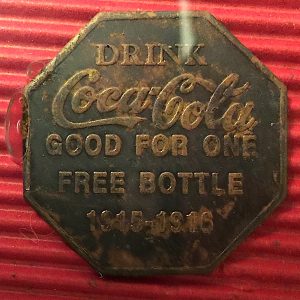
Token for a free bottle of Coca-Cola in 1915-16
As I was sorting through the collection, I found a frame with an octagonal token “Good for one free bottle” of Coca-Cola dated 1915-1916. The token is in pretty decent shape although has been well handled. The problem is that it appears to be glued to the backing. The back of the frame also has writing indicating that it was a gift to the former owner.
I have seen similar tokens before, such as the Colgate-Palmolive-Peet token I previously wrote about, but never on for Coca-Cola. I am sure that these are relatively common for advertising tokens.
For a Coca-Cola collector, it is a nice gift. For a numismatist interested in the token, I am worried that such a piece may be damaged. Before I decide whether to free the token from its frame, I have to decide whether it would be better sold as a framed item or with the token. I also have to decide whether I want to keep this token!
I better be careful because if I keep finding all of these fascinating advertising tokens I might end up keeping them and starting a collection.

Full framed image of the Coca-Cola advertising toen
Dec 5, 2016 | books, Canada, coins, currency, review, tokens
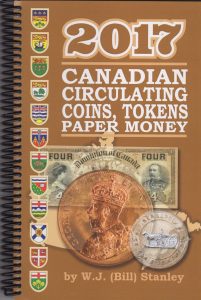 If you are a collector of Canadian coins and looking for a standard reference, there is nothing better than The Charlton Standard Catalogue of Canadian Coins. Available in two volumes, the Charlton catalogs would be the Canadian equivalent of the Red Book Professional Edition. Charlton Press also publishes books for the Canadian currency and token collectors. All of the Charlton books are very comprehensive on their respective topic and a must for the Canadian collector.
If you are a collector of Canadian coins and looking for a standard reference, there is nothing better than The Charlton Standard Catalogue of Canadian Coins. Available in two volumes, the Charlton catalogs would be the Canadian equivalent of the Red Book Professional Edition. Charlton Press also publishes books for the Canadian currency and token collectors. All of the Charlton books are very comprehensive on their respective topic and a must for the Canadian collector.
Like the Professional Edition of the Red Book, the Charlton Catalog is not a quick or portable reference. When I am searching through coins at shows or if I am just trying to identify something I had just acquired, I want a quicker reference with some basic prices that does not require me to hunt around the other information I am not interested in at the moment. I think I found the perfect reference for Canadian numismatics.
While searching one of my favorite online coin supply retailers, I came across the 2017 by W.J. (Bill) Stanley. It is published by Canadian Wholesale Supply of Paris, Ontario. Within the book, it does not carry a copyright date and it does not have an International Standard Book Number (ISBN). It can be found at a number of online numismatic stores but not on stores like Amazon that require an ISBN.
But if you are collecting Canadian Coins, Breton Tokens, or Canadian Paper money you should have a copy of this book sitting next to your Charlton Standard Catalog. While the Charlton books are very complete with a lot of information, the pictures are in black and white. All of the coin images in the Stanley book are in color. Although you can guess what the colors are, seeing the color images on varieties and being able to compare them with coins is of great help.
Canadian Coin Section sample pages
-

-
Index of the Coin and Currency Section
-
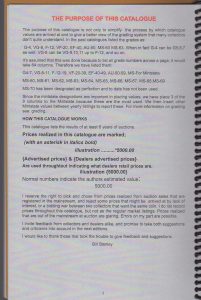
-
Bill Stanley’s purpose of this book
-
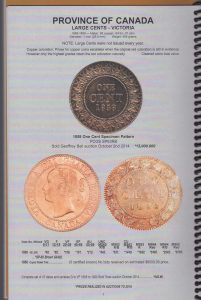
-
Sample of the Vicki Cents
-
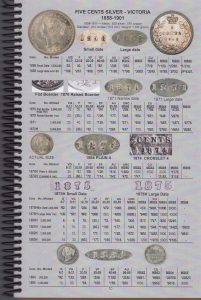
-
Sample page showing how varieties are illustrated
Another advantage of the Stanley book is that it consists only of circulating coinage. Although the Royal Canadian Mint has expanded its catalog of non-circulating legal tender coins over the last decade, if you are just collecting circulating issues, then the other stuff is clutter. It is just the basics of what was circulated in Canada.
This book is divided into three section. The first are circulating Canadian coins, the second for Canadian currency, and final are the tokens. The coin and currency section has a single introduction, guide to reading the tables, and an index to find the particular type you might try to find. The coin section has their pages numbered beginning with page 1 with the introductory parts numbered with Roman numerals. But the currency section begins on page B-1 following page 54 of the coins.
Canadian Currency Section sample pages
-
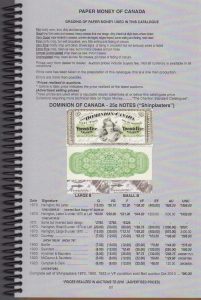
-
Beginning of the currency section
-
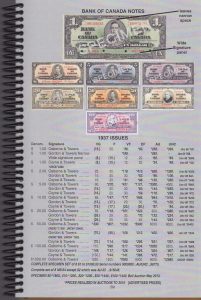
-
A sample page of the currency section
The tokens section appears as if it was a separate book bound with the coin and currency section to make one book. It has a title page followed by a similar introduction, guide to reading the information, and an index. The introductory pages are not numbered but the token listings begin on page T-1.
Breton Tokens Section sample pages
-
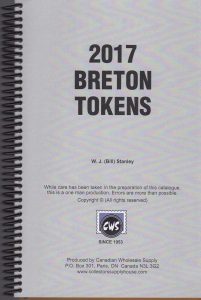
-
Title page of the Breton Tokens section
-
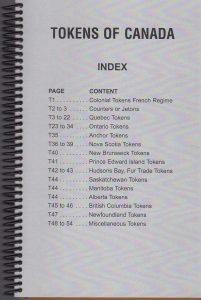
-
Index to the Breton Tokens section
-
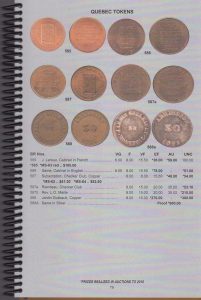
-
A sample from the Breton Tokens section
-
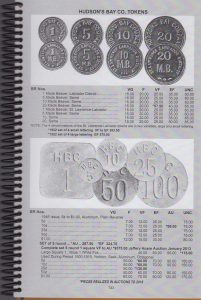
-
A sample from the Breton Tokens section
If the book was bigger, these page numbering anomalies would be confusing. I only noticed this when I tried to figure out how many pages are in the book. Considering that not every page is numbered and there are some blank pages in the middle, I think there are 132 pages in total. Not very thick and spiral bound for easier handling.
Prices in the book are given for the basic grades and includes prices for significant auctions and prices gathered for rare and significant coins. As most of us are aware, most printed price books are obsolete by the time they are published. What Stanley does is use information he gathers from auctions and coin shows around Canada to determine the prices. In his introduction, Stanley admits he uses his judgment to exclude what appears to be bogus data based on bidding wars or data from untrustworthy sources. He also admits that there may be errors.
Without reaching out to Stanley, it appears he is the sole responsible person for the prices and content of this guide. Maybe that is a good thing considering the inaccuracy of similar guides from other publishers. However, after go through his guide and a number of other sources including the prices from a few Canadian dealers, this book may be more accurate than his caveat suggests.
After that, it is pages of coin listings similar to any price guide you may find. The number of coins minted is included on each line. There are images of coins, images of varieties with an arrow point to subtle differences, and prices in the most relevant grades of circulating coins.
I cannot speak about the Charlton Standard Catalog of Canadian Currency since I do not own that book, but similar to the coins’ section, the Canadian currency section is nothing but the basics. Color images are reproduced from the Bank of Canada and have “SPECIMEN” superimposed on each note. Descriptions note signature, portrait, and serial number differences (i.e., prefix types) for the notes and the prices in the most relevant grades.
Tokens are a very important part of the history of Canadian money. When coins or currency was not available, Canadian towns and provinces created tokens to act in the place of money. The history of Canadian tokens is fascinating and worth another report. It is important to note that the cataloging of tokens is based on the work Pierre Napoleon Breton in his book Illustrated History of Coins and Tokens Related to Canada originally published in 1894, since republished and updated. As part of his cataloging of tokens, he assigned them a number that is now known as Breton Numbers. Stanley lists Canadian tokens by Breton Numbers.
Although I am not a collector of Breton Tokens, I am fascinated by other areas of numismatics especially if they are different. What thrills me about this section is that the tokens are imaged side-by-side with their basic information and prices. It is not a tome on their history but if I was a collector, it would help me identify these tokens and what I might expect to pay for them. I found myself flipping through the pages looking at the tokens, what they say, and thinking about their possible history. I want to go back through my back issues of The CN Journal (publication of the Royal Canadian Numismatic Association) and find some of those stories about tokens I never read.
Flipping the pages of such as basic reference, I never thought I would learn so much. I think it is because all of the other information has been omitted, I can see the coins, images of the varieties, and the prices without distraction. Now that I have learned a number of things, I can pick up other references to learn more.
My only minor nit about this book is the page numbering scheme and the lack of coherent index or table of contents. I give it a grade of MS-68 for being a simple reference of circulating Canadian numismatics and a book that I recommend.
Sep 22, 2016 | copper, history, markets, tokens
Have you noticed that every election “is the most important in our history?” Or that “you have no clearer choice” than whatever any of the candidates are selling? There are so many clichés that it would require its own blog post.
But what does that have to do with numismatics?
Long-Stanton Manufacturing Company was founded in 1862 by John Stanton to make copper tokens that were used by merchants in the Cincinnati area when money was in short supply during the Civil War. Before starting his company, Stanton owned a company that provided the illustrations and dies that were used to make advertising tokens for the 1860 election.
The Election of 1860 preceded the outbreak of the Civil War. It featured fractured party nominees arguing over the future of the union. The Republican Party, formed out of the ashes of the Whig Party, nominated former representative from Illinois Abraham Lincoln. The Democratic Party nominated Illinois Senator Stephen A. Douglas. But the Democrats were split along the issue of slavery. Pro-slavery southern Democrats formed their own party and nominated then Vice President John C. Breckinridge from Kentucky. A few other candidates were nominated but these were the three that were the focus of the election.
One thing that is considered a highlight of this campaign were the famous debates between Abraham Lincoln and Stephen Douglas. The main theme of the seven debates was slavery. Primarily, Lincoln was anti-slavery and maintaining the union. Douglas was not pro-slavery but favored new territories to choose their own paths. Lincoln argued in his “House Divided” speech that Douglas wanted to nationalize slavery. This came following Douglas’s sponsoring of the Kansas-Nebraska Act that repealed the ban on slavery in the new territories passed as part of the Missouri Compromise.
Although the use of language was more refined in 1858, the issues were just as divisive.
Seven debates were not enough for the public. Manufacturers, such as the one that Stanton provided illustration and die making services for, struck tokens for the candidates and their supporters to give away to gain support. Lincoln won the Election of 1860 with a majority of the electoral votes carrying 18 of 33 states while gaining only 39.8-percent of the popular vote.
Some say the election of 2016 is the most divided in our history. If we do not count the Election of 1824 in which nobody received a majority of electoral votes and the results had to be decided by the House of Representatives, it could be one of the more contentious election since the 1976 Carter-Ford race.
The folks at Long-Stanton thinks there is an indecision in this election, although the polls show that the country is about evenly split. They think to celebrate the 156 years since John Stanton created his tokens the company created their Indecision 2016 token.
Indecision 2016 token is 39mm and made of brass. Portraits of each of the candidates are on either side. If you are undecided, you can flip the token to choose who you will vote for.
Unfortunately, the portraits barely represent the candidates. While the TRUMP side of the token is passible the CLINTON side would not be recognizable if it was not marked. While I do not consider either candidate physically attractive these portraits are worse.
Since it is expensive to produce tokens and medals to just give away, the tradition of striking these types of pocket pieces are no longer part of the campaign. If you have ever read Warman’s Political Collectibles: Identification and Price Guide, you would see all the interesting trinkets that would be produced in support of the candidates. Nowadays, those who collect political memorabilia would be hard pressed to find something more than a button or lapel pin.
Having received the Brexit token, I decided to purchase one of the Long-Stanton Indecision 2016 tokens for my collection. Although the token looks better in hand since it has a proof-like strike, a close-up view of the portraits are about as bad as the images on Long-Stanton’s website. For $8.95 for a single token, including shipping, it is not a bad deal. They do offer discounts for buying more than a few.
-
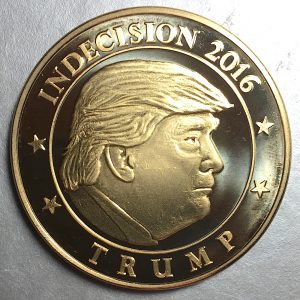
-
Long-Stanton Indecision 2016 Token – Donald Trump side
-
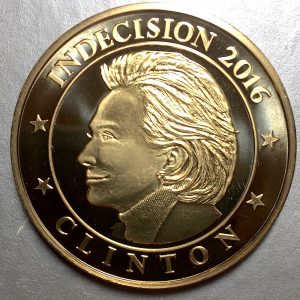
-
Long-Stanton Indecision 2016 Token – Hillary Clinton side
Included in the package was an aluminum token from Long-Stanton that is “GOOD FOR 50 IN MERCHANDISE.” It does not identify the exact value of 50 whether it means cents or dollars, but it does not matter since it is unlikely to be redeemed from my collection. At 31mm it is smaller than the Indecision 2016 token but it is a throwback to times when tokens were created for store credit before paper coupons became ubiquitous.
-
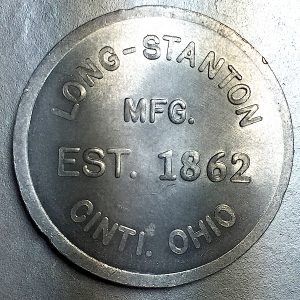
-
Aluminum Long-Stanton Manufacturing Token
-

-
Aluminum Long-Stanton Manufacturing Token reverse offering “50 IN MERCHANDISE”
Rather than go with my numismatic collection, this token will go along with a small collection I have of political memorabilia. It will join other numismatic-related items that are related to my favorite president Teddy Roosevelt. I hope he is not insulted by either of these candidates. Somehow, I think T.R., George Washington, Thomas Jefferson and Abraham Lincoln might not be happy if they were around today.
Aug 6, 2016 | economy, history, tokens
For as long as there has been money or commerce, there has been some form of credit. Whether it was borrowing a few coins until the next payday or today’s credit cards, credit has been a fuel of economic development for quite some time. The financial industry is built on credit and charging customers to borrow money and spread the payments out over time. By some estimates the average household owes over $16,000 in credit card debt.
The United States was founded on credit. During the founding of the country currency had been limited to coins with an intrinsic value based on their gold, silver or copper content. As the King of England tried to tax the colonies to pay for the wars in Europe, the colonies looked for ways of financing their own governments to provide services. they issued paper notes. These notes functioned as currency but actually were bills of credit, short-term public loans to the government. For the first time, the money had no intrinsic value but was valued at the rate issued by the government of the colony in payment of debt. Every time the colonial government would need money, they would authorize the printing of a specified quantity and denomination of notes that it would use to pay creditors. The emission laws also included a tax that would used to repay the bill of credit and the promised interest.
Later, the era we now refer to as Obsolete Banknotes (or Broken Banknotes), were currency issued by banks under permission of the Department of the Treasury that were supposed to be backed by the assets of the issuing bank. Banks were supposed to be able to back at least 90-percent of the value of the notes with hard currency. But the banks were not honest with the Treasury Department, issued more currency than assets, and many went out of business because they could not cover the value of the notes issued.
Credit run amok has been the cause of nearly every major market downturn in history including the most recent dire recession that began in 2008.
The concept of institutionalizing consumer debt was first written about in Looking Backward, 2000 to 1887 by Edward Bellamy. Bellamy, a writer from Massachusetts, wrote about Julian West, a young American who falls into a deep, hypnotic sleep and wakes up in the year 2000. As part of West’s experience, Bellamy describes purchases being made using a credit card. Bellamy’s credit card was limited to the amount on deposit. The description is more like a debit or secured credit card of today. After the book became popular, the concept of consumer credit began to be institutionalized.
Hotels and other higher-end retailers were first. They would create medals or tokens that could be carried in the pocket or have a hole to include them on a keychain. Much like the Colgate tokens previously written about, the use of metal tags and tokens began at the beginning of the 20th century and was stopped by the War War II efforts.
Credit tokens were nondescript items with the name of the establishment and the user’s account number which lead to a number of problems. Since the account number was engraved into the tag, it was up to the cashier to write down the account number. Mistakes would lead to unpaid bills. A later improvement was to include raised letters that could be rubbed onto the paper using a pencil or carbon paper in order to record the number correctly, a feature that would be added to the plastic charge plate before the invention of the magnetic strip.
These tokens did not include the customer’s name. Although many can be mailed to the company so that the keys could be returned to the original owner, thieves would keep the tokens and use them. Stores would later have to produce lists of invalid or stolen charge numbers to verify the sale at the register. In the day before computers, this was a time consuming task.
Stores continue to think the risks are worth dealing with since credit purchases appear to be more popular than cash-based purchases.
One of the early adopters of credit purchases was Abraham & Straus, Inc. Founded in 1865 by Abraham Abraham in Brooklyn, the store was operated on Fulton Street as a small clothing outlet until its later flagship store was built closer to downtown Brooklyn in 1883. As part of expanding the store and funding the move, Abraham received funding from Nathan and Isidore Straus. When the company reopened at 422 Fulton Street the was renamed Abraham & Straus, the name that was used until its closing in 1995.
-
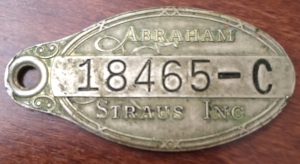
-
A&S Charge Token with account number
-
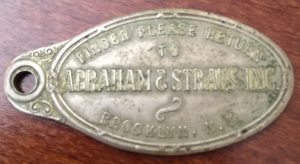
-
If found return it to A&S in Brooklyn!
Known as A&S throughout the New York metropolitan area, it was a little more upscale from other discount stores of the time. Although the stores expanded as far as the Philadelphia region, it would not see the same success as the New York-area stores. A&S was a favorite amongst the burgeoning middle class of the post-World War II Baby Boomer generation especially for women’s clothes. I have a lot of memories waiting outside of the A&S with my father at the Green Acres Mall in Valley Stream, NY as my (late) mother would go shopping in A&S. And the family car, a black 1963 Chevy Impala with red interior, did not include air conditioning!
Apparently, I survived those shopping trips along with my recent find an on old A&S credit token. While searching through a cigar box of old tokens, I found this pre-World War II item. Aside from bringing back the memories, and reminder of the hot days waiting for my mother to try on nearly every dress in the store, I though this would be a perfect addition to my collection of New York numismatic memorabilia.
Remember, you do not have to collect coins to have fun with numismatics!
NOTE: Electronic versions of
Looking Backward, 2000 to 1887 by Edward Bellamy can be downloaded from
Project Gutenberg.
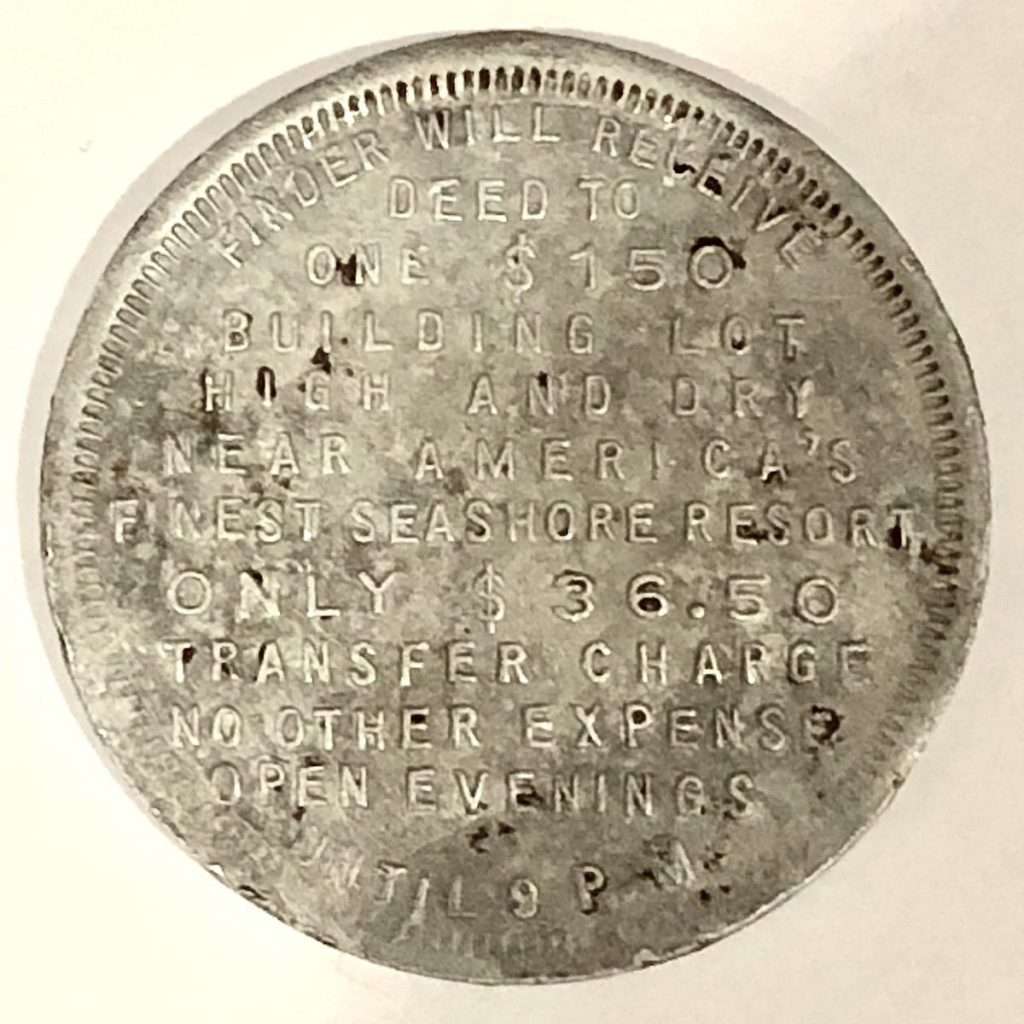










 → Read more at
→ Read more at 



















